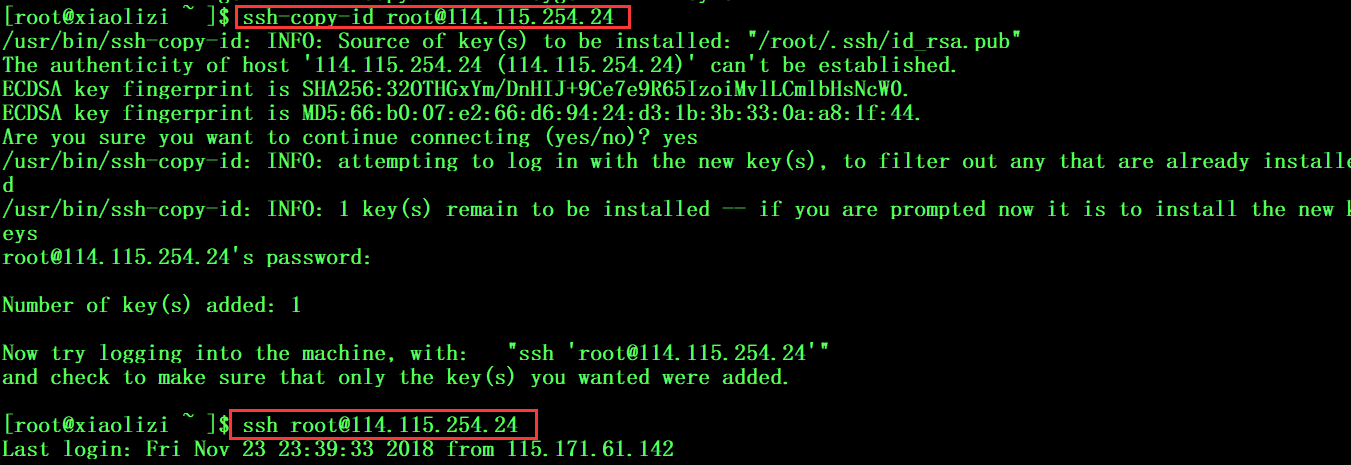
Note : Before booting a new kernel, you can check its configuration

Kernel configuration found at /boot/config-3.10.0-862.11.6.el7.x86_64ĬONFIG_NETFILTER_XT_TARGET_CHECKSUM: enabled Kernel configuration not found at /proc/config.gz searching. Sep 27 09:16:59 systemd: Started LXC Container Initialization and Autoboot ~]# lxc-checkconfig Sep 27 09:16:59 lxc-autostart-helper: Starting LXC autoboot containers: Sep 27 09:16:29 lxc-devsetup: /dev is devtmpfs Sep 27 09:16:29 systemd: Starting LXC Container Initialization and Autoboot Code. Main PID: 10272 (code=exited, status=0/SUCCESS) Process: 10269 ExecStartPre=/usr/libexec/lxc/lxc-devsetup (code=exited, status=0/SUCCESS) Process: 10272 ExecStart=/usr/libexec/lxc/lxc-autostart-helper start (code=exited, status=0/SUCCESS) Loaded: loaded (/usr/lib/systemd/system/lxc.service disabled vendor preset: disabled)Īctive: active (exited) since Thu 09:16:59 MSK 5min ago
LXC SSH COPY ID CODE
Б≈▐ lxc.service - LXC Container Initialization and Autoboot Code Iptables -t mangle -A POSTROUTING -o lxcbr0 -p udp -m udp -dport 68 -j CHECKSUM -checksum-fill Iptables -I INPUT -i lxcbr0 -p udp -dport 53 -j ACCEPT Iptables -I INPUT -i lxcbr0 -p tcp -dport 53 -j ACCEPT Iptables -I INPUT -i lxcbr0 -p tcp -dport 67 -j ACCEPT Iptables -I INPUT -i lxcbr0 -p udp -dport 67 -j ACCEPT dhcp-leasefile=/var/run/lxc-dnsmasq.leases \

LXC SSH COPY ID INSTALL
Yum -y install lxc dnsmasq-base bridge-utils lxc lxc-templates lxc-extras dnsmasqīridge-utils iptables-services debootstrap perl libvirtġ) vi /etc/systemd/system/rviceĢ) vi /etc/systemd/system/rviceĭescription=Bridge interface for LXC ContainersĮxecStart=/sbin/ip address add 10.0.3.1/24 dev lxcbr0 Yum install install systemd-services cgroup-bin Later on, when defining the network in OpenNebula, you will specify the name of this bridge and OpenNebula will know that it should connect the VM to this bridge, thus giving it connectivity with the physical network device connected to the bridge.First of all, we need to make some preparations for LXC infrastructure. For this driver, you will need to setup a Linux bridge and include a physical device in the bridge. You may want to use the simplest network model, that corresponds to the bridged driver. There are various models for Virtual Networks, check the Open Cloud Networking chapter to find the ones supported by OpenNebula. It is highly recommended to use a dedicated network for this purpose. Network connection is needed by the OpenNebula Front-end daemons to access, manage and monitor the Hosts, and to transfer the Image files. # from Front-end to Front-end itself ssh exit # from Front-end to node, back to Front-end and to other nodes ssh ssh exit ssh exit ssh exit exit # from Front-end to node, back to Front-end and to other nodes ssh ssh exit ssh exit ssh exit exit # from Front-end to nodes and back to Front-end and other nodes ssh ssh exit ssh exit ssh exit exit Step 5. It should be executed on your Front-end under oneadmin user and copied on all your Nodes. The file is located in /var/lib/one/.ssh/known_hosts and we can use the command ssh-keyscan to manually create it. known_hosts) so that all communicating parties know the identity of the other sides. You should prepare and further manage the list of host SSH public keys of your nodes (a.k.a.

To learn more about the SSH, read the Advanced SSH Usage guide. While the authentication agent is used, you don’t need to distribute private SSH key from Front-end to hypervisor Nodes! Access to this agent is delegated (forwarded) from the OpenNebula Front-end to the hypervisor Nodes for the operations which need to connect between Nodes or back to the Front-end. On the Front-end runs dedicated SSH authentication agent service which imports the oneadmin’s private key on its start. In this guide, we are going to manually use SSH tools. Ultimately the administrator should choose a method the recommendation is to use a configuration management system (e.g., Ansible or Puppet). There are many methods to achieve the distribution of the SSH keys. To enable passwordless connections you must distribute the public key of the oneadmin user from the Front-end to /var/lib/one/.ssh/authorized_keys on all hypervisor Nodes. It happens only if these files don’t exist yet, existing files (e.g., leftovers from previous installations) are not touched! For new installations, the default SSH configuration is placed for the oneadmin from /usr/share/one/ssh into /var/lib/one/.ssh/config. When OpenNebula server package is installed on the Front-end, a SSH key pair is automatically generated for the oneadmin user into /var/lib/one/.ssh/id_rsa and /var/lib/one/.ssh/id_rsa.pub, the public key is also added into /var/lib/one/.ssh/authorized_keys.
LXC SSH COPY ID MANUAL
It must be ensured that Front-end and all Nodes can connect to each other over SSH without manual intervention.


 0 kommentar(er)
0 kommentar(er)
